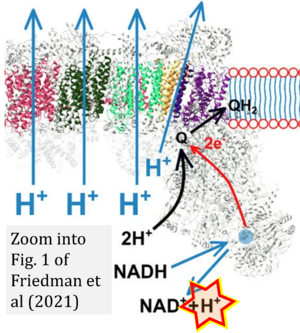Friedman 2021 Quantum Reports
| Friedman J, Mourokh L, Vittadello M (2021) Mechanism of proton pumping in Complex I of the mitochondrial respiratory chain. Quantum Reports 3:425-34. https://doi.org/10.3390/quantum3030027 |
Friedman J, Mourokh L, Vittadello M (2021) Quantum Reports
Abstract: We propose a physical mechanism of conformation-induced proton pumping in mitochondrial Complex I. The structural conformations of this protein are modeled as the motion of a piston having positive charges on both sides. A negatively charged electron attracts the piston, moving the other end away from the proton site, thereby reducing its energy and allowing a proton to populate the site. When the electron escapes, elastic forces assist the return of the piston, increasing proton site energy and facilitating proton transfer. We derive the Heisenberg equations of motion for electron and proton operators and rewrite them in the form of rate equations coupled to the phenomenological Langevin equation describing piston dynamics. This set of coupled equations is solved numerically. We show that proton pumping can be achieved within this model for a reasonable set of parameters. The dependencies of proton current on geometry, temperature, and other parameters are examined.
• Bioblast editor: Gnaiger E
Hydrogen ion ambiguities in the electron transfer system
Communicated by Gnaiger E (2023-10-08) last update 2023-11-10
- Electron (e-) transfer linked to hydrogen ion (hydron; H+) transfer is a fundamental concept in the field of bioenergetics, critical for understanding redox-coupled energy transformations.
- However, the current literature contains inconsistencies regarding H+ formation on the negative side of bioenergetic membranes, such as the matrix side of the mitochondrial inner membrane, when NADH is oxidized during oxidative phosphorylation (OXPHOS). Ambiguities arise when examining the oxidation of NADH by respiratory Complex I or succinate by Complex II.
- Oxidation of NADH or succinate involves a two-electron transfer of 2{H++e-} to FMN or FAD, respectively. Figures indicating a single electron e- transferred from NADH or succinate lack accuracy.
- The oxidized NAD+ is distinguished from NAD indicating nicotinamide adenine dinucleotide independent of oxidation state.
- NADH + H+ → NAD+ +2{H++e-} is the oxidation half-reaction in this H+-linked electron transfer represented as 2{H++e-} (Gnaiger 2023). Putative H+ formation shown as NADH → NAD+ + H+ conflicts with chemiosmotic coupling stoichiometries between H+ translocation across the coupling membrane and electron transfer to oxygen. Ensuring clarity in this complex field is imperative to tackle the apparent ambiguity crisis and prevent confusion, particularly in light of the increasing number of interdisciplinary publications on bioenergetics concerning diagnostic and clinical applications of OXPHOS analysis.
Labels:
Enzyme: Complex I



